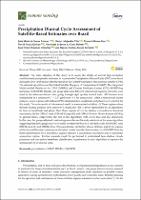Mostrar el registro sencillo del ítem
Precipitation diurnal cycle assessment of satellite-based estimates over Brazil
| dc.contributor.author | Afonso, J.M.S. | |
| dc.contributor.author | Vila, D.A. | |
| dc.contributor.author | Gan, M.A. | |
| dc.contributor.author | Quispe, D.P. | |
| dc.contributor.author | Barreto, N.J.C. | |
| dc.contributor.author | Huamán, Joao | |
| dc.contributor.author | Palharini, R.S.A. | |
| dc.date.accessioned | 2020-08-06T21:27:20Z | |
| dc.date.available | 2020-08-06T21:27:20Z | |
| dc.date.issued | 2020-07-21 | |
| dc.identifier.citation | Afonso, J.M.S.; Vila, D.A.; Gan, M.A.; Quispe, D.P.; Barreto, N.J.C.; Chinchay, J.H.H.; Palharini, R.S.A. (2020). Precipitation diurnal cycle assessment of satellite-based estimates over Brazil Remote Sens. 2020, 12(14), 2339 Doi: 10.3390/rs12142339 | en_US |
| dc.identifier.uri | https://hdl.handle.net/20.500.12542/466 | |
| dc.description.abstract | The main objective of this study is to assess the ability of several high-resolution satellite-based precipitation estimates to represent the Precipitation Diurnal Cycle (PDC) over Brazil during the 2014–2018 period, after the launch of the Global Precipitation Measurement satellite (GPM). The selected algorithms are the Global Satellite Mapping of Precipitation (GSMaP), The Integrated Multi-satellitE Retrievals for GPM (IMERG) and Climate Prediction Center (CPC) MORPHing technique (CMORPH). Hourly rain gauge data from different national and regional networks were used as the reference dataset after going through rigid quality control tests. All datasets were interpolated to a common 0.1° × 0.1° grid every 3 h for comparison. After a hierarchical cluster analysis, seven regions with different PDC characteristics (amplitude and phase) were selected for this study. The main results of this research could be summarized as follow: (i) Those regions where thermal heating produce deep convective clouds, the PDC is better represented by all algorithms (in term of amplitude and phase) than those regions driven by shallow convection or low-level circulation; (ii) the GSMaP suite (GSMaP-Gauge (G) and GSMaP-Motion Vector Kalman (MVK)), in general terms, outperforms the rest of the algorithms with lower bias and less dispersion. In this case, the gauge-adjusted version improves the satellite-only retrievals of the same algorithm suggesting that daily gauge-analysis is useful to reduce the bias in a sub-daily scale; (iii) IMERG suite (IMERG-Late (L) and IMERG-Final (F)) overestimates rainfall for almost all times and all the regions, while the satellite-only version provide better results than the final version; (iv) CMORPH has the better performance for a transitional regime between a coastal land-sea breeze and a continental amazonian regime. Further research should be performed to understand how shallow clouds processes and convective/stratiform classification is performed in each algorithm to improve the representativity of diurnal cycle. | en_US |
| dc.format | application/pdf | |
| dc.language.iso | eng | en_US |
| dc.publisher | MDPI AG | en_US |
| dc.relation.ispartof | urn:issn:2072-4292 | |
| dc.rights | info:eu-repo/semantics/openAccess | en_US |
| dc.rights | Atribución-NoComercial-SinDerivadas 3.0 Estados Unidos de América | * |
| dc.rights.uri | http://creativecommons.org/licenses/by-nc-nd/3.0/us/ | * |
| dc.source | Repositorio Institucional - SENAMHI | en_US |
| dc.source | Servicio Nacional de Meteorología e Hidrología del Perú | en_US |
| dc.subject | Satélite | en_US |
| dc.subject | Hierarchical systems | en_US |
| dc.subject | Statistical tests | en_US |
| dc.subject | Rain gages | en_US |
| dc.subject | Precipitación | en_US |
| dc.title | Precipitation diurnal cycle assessment of satellite-based estimates over Brazil | en_US |
| dc.type | info:eu-repo/semantics/article | en_US |
| dc.identifier.isni | 0000 0001 0746 0446 | |
| dc.description.peerreview | Por pares | |
| dc.identifier.doi | https://doi.org/10.3390/rs12142339. | |
| dc.identifier.journal | Remote Sensing | |
| dc.source.journal | Remote Sens | |
| dc.subject.ocde | https://purl.org/pe-repo/ocde/ford#1.05.10 | |
| dc.subject.sinia | precipitacion - Clima y Eventos Naturales | |
| dc.type.sinia | text/publicacion cientifica | |
| dc.identifier.url | https://hdl.handle.net/20.500.12542/466 |
Ficheros en el ítem
Este ítem aparece en la(s) siguiente(s) colección(es)
-
Artículo científico [171]









